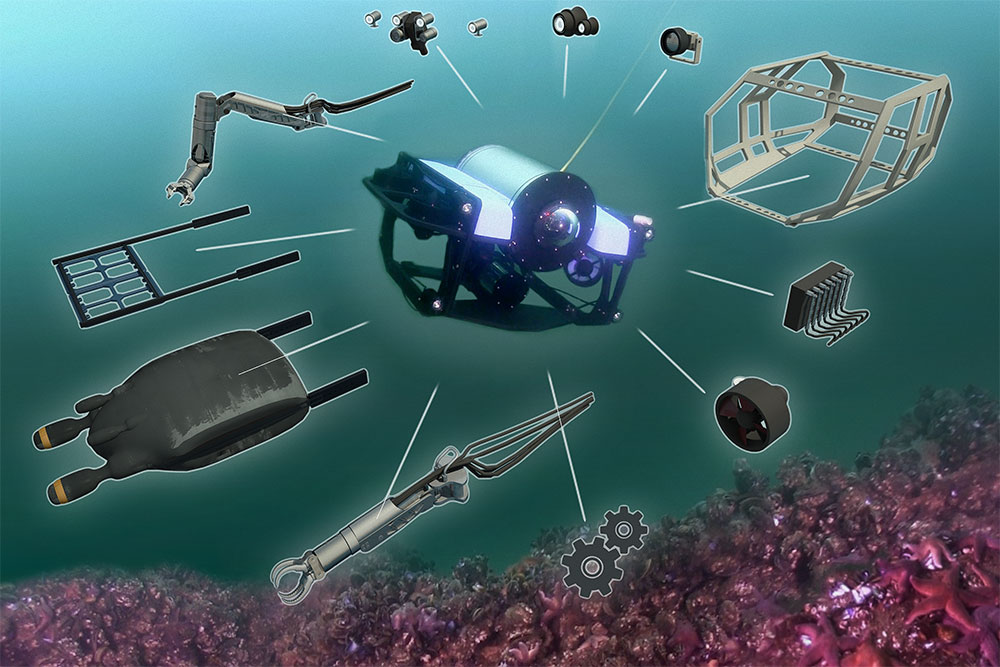Practical test passed: Rostock researchers develop modular system for underwater vehicles
A project group in Rostock has developed a modular system for underwater vehicles consisting of components that can be readily combined with each other. These modular remote-operated vehicles (ROVs) can be used in various scenarios -- a first in underwater technology. The prototype has now passed testing in the Baltic Sea.

Today’s standard ROVs are typically custom products designed for traditional uses, primarily in the oil and natural gas industry. These vehicles lack multifunctionality according to users whose feedback formed the basis for the project “MiRo-Base”. New uses arising from the increasing industrialization of the ocean require new concepts and design possibilities. This is why a project group from Fraunhofer IGD, FORTecH Software GmbH, SubCtech GmbH, IAV GmbH and the University of Rostock set about developing a flexible system for underwater vehicles.
A new generation of ROVs
The modular construction created a set of entirely new challenges for the developers. The flexible design of the vehicle meant the software had to be flexible as well, so that newly developed drives, for example, can even be actuated in the first place. The solution by Rostock software company FORTecH can readily integrate various elements without having to reprogram the configuration of the equipment each time. The Chair of Control Engineering at the University of Rostock worked with IAV GmbH to develop an all-new control system that automatically adapts to the vehicle configuration. This smart controller is based on a mathematical model for vehicle movement worked out by the Chair of Ocean Engineering at the University of Rostock. Fraunhofer IGD contributed a smart camera for the new generation of ROVs. This camera enhances underwater images in real time, filtering out turbidity, color cast, blur, and refraction to make the image substantially clearer. This image is transmitted live to the underwater vehicle operator to assist them in deciding on the next step while the vehicle is still submerged.
Trial run for the new ROV
Just prior to the end of the project, which was funded by Germany’s Federal Ministry for Education and Research, one of the two prototypes underwent a final practical test. In cooperation with the Mecklenburg-West Pomerania State Association for Underwater Archeology, a test dive of eight meters was conducted down to a shipwreck off the coast of Warnemünde, Germany, in the Baltic Sea. Research diver Martin Siegel accompanied the underwater vehicle down to the sunken 16-meter tugboat: “We were really pleasantly surprised by the quality of the underwater images -- what the camera can do in such poor visibility is astounding.” Even the developers themselves appeared satisfied after the test dive: “With the developed control algorithms, operating the ROV was very easy and even possible for less-experienced personnel,” said Thilo Müller, control engineer at the University of Rostock and pilot of the ROV during the dive. To test the new functions and equipment, the company Evologics in Berlin also developed a second bionic prototype shaped like a turtle, showing what new forms of ROV this new kit will make possible.
Where humans meet their limits, technology steps in
Yet why is an underwater robot needed for something humans themselves have been able to do so far? Siegel clarified, “We often come to the point where we detect something unusual on the sonar but can’t dive there or can only dive there with certain risks, like diving to great depths or to sites where ascent isn’t possible or there’s a significant risk of getting stuck. Even the ocean current is often a challenge to divers engaged in high-quality documentation. In general, we operate in an environment that’s very hostile to the work we do -- with technology, we can provide relief.” The use of technology also brings with it advantages in terms of time and money. Complex exploration dives can only be done a bit at a time due to strict rules on dive and break times. A vehicle, on the other hand, can dive as long as its battery can last. Speaking of which, the new mini-ROV comes with the latest generation of lithium-ion battery. Developed by Kieler SubCtech GmbH, this lithium-ion battery supplies and monitors power, and automatically recharges itself, even under water. It also can be easily adapted for a variety of uses.
New applications through better technology
When sonar detects an unusual object, the state association divers need to act quickly. In the case of the sunken Dutch boat off the coast of Warnemünde, a plethora of material that could have provided valuable clues as to the identity of the boat and its demise was lost due not only to ocean currents but also plundering. In the future, the use of technology could result in historically valuable structures being located much more quickly than with divers, especially at certain depths. “With the underwater vehicle, we hope to go places we can’t even get to without the help of technology,” summarized Siegel of his expectations of his new teammates. Over the course of the year, Evologics GmbH will finalize development of the turtle ROV and then launch it on the market as a product. As far as the research in Rostock goes, the next steps are already in the making. “In a follow-up project, we want to focus on how an ROV can use artificial intelligence during a dive to control itself and explore something like a wreck all on its own,” said Guntram Flach, project manager at Fraunhofer IGD. The vision: a cognitive ROV. Such a vehicle could be tested at the underwater testing grounds of the “Digital Ocean Lab” slated to be constructed of the coast of Nienhagen, Germany.
Further information:
- More about the project MiRo-Base (igd.fraunhofer.de)
 Fraunhofer Institute for Computer Graphics Research IGD
Fraunhofer Institute for Computer Graphics Research IGD